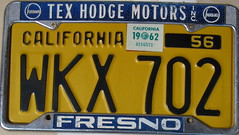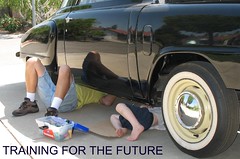Announcement
Collapse
No announcement yet.
Cooled Water Heater Installations Part II
Collapse
X
-
Rich, I'm not going to dispute what you say. But what difference does
it make which way the water flows? Thanks
Just saw post #1. Now I know why my new heater control valve doesn't
work.Last edited by paul shuffleburg; 03-12-2017, 06:55 AM.
Comment
-
When I bought my 1950 Champion I noticed a couple things wrong with my hoses also. The clamp on the inner fender should be turned half way around to hold the hose further away from the engine, and the hose should be about 6" longer. The second picture shows the thermostat hoses swapped. The hose off the head should go to the bottom of the thermostat to be correct, and this will also keep the other hose off the plugs wires.
Comment
-
I am amazed at what pops up here. Honestly, after all these years, I've never given heater hose routing much thought. I have changed several on my vehicles. On the Land Cruiser, I believe there is a total of about 18 feet of heater hose, when you take into account the lines to the under seat heater & defroster heater core. I replaced all of those hoses. I have always put them back in the order I found them. If a previous owner did them wrong, then they are still that way.
Now, I am curious. In a thermostatically controlled circulation system, how cool does the water in the radiator get, once the vehicle is underway, and the water is flowing continually? As it is really a "heat exchange ratio" vs a percentage of "ambient" air temperature, does it have enough dwell time in the radiator to reach ambient temperature, or does it maintain enough warmth to be close to engine operating temp? Anyone ever install a temp gauge on the radiator side to compare? Just asking?John Clary
Greer, SC
SDC member since 1975
Comment
-
Actually it DOES matter which way the water flows.Originally posted by paul shuffleburg View PostRich, I'm not going to dispute what you say. But what difference does
it make which way the water flows? Thanks
Just saw post #1. Now I know why my new heater control valve doesn't work.
It makes a Big difference if the Hottest Water from the Water Pump Inlet is not being controlled by the Water Valve and not sent INTO the Heater Core. Plus HOW would you shut it OFF?
You also will get more Heat if you use the UNCOOLED by the Rad. water, instead of the Cooled Water.
That is the whole point of a Hot Water heating system, you use the hottest water (OK Coolant) FROM the Engine, not TO the Engine from the Radiator to be controlled and sent to the Core.
As far as which Heater Tube you use, that has little if any affect, but there no reason not to use the Factory position of Lower Tube is the Inlet from the Valve, NOT the Engine.StudeRich
Second Generation Stude Driver,
Proud '54 Starliner Owner
SDC Member Since 1967
Comment
-
I fail to understand how cold is entering the heater.
The water is flowing out the upper part of the manifold. That is the hot side. It will enter the heater, which side of the heater makes little difference. Much like a light bulb, polarity/flow makes no difference. The hot water comes out of the top manifold due to flow direction generated by the pump. The water then passes through the heater core and cools, the enters the lower manifold which is the cold side. Theoretically, the heater will be more efficient if the hot water enters the upper side of the heater core.
Now, the valve, that can be different. Some are directional, run the flow backwards and the valve can fail to control the flow. Whether the valve is upstream or downstream is irrelevant as long as the direction of flow through the valve matches is flow direction is called out
Then again, what do I know?
Ken Buchanan
Comment
-
It has been over 40 years but I used to run some cooling tests on class 8 trucks with Detroit Diesel engines the numbers we always recorded were ambient air to water out and water in and air to boil.These test were ran on a dyno at full horsepower and just fan air and no ram air. We had charts that we used to determine if cooling system passed or failed. We would also inject air in to the system to determine how much the system could handle without reducing water flow.because all Diesel engines put air in the cooling system.
Comment




Comment